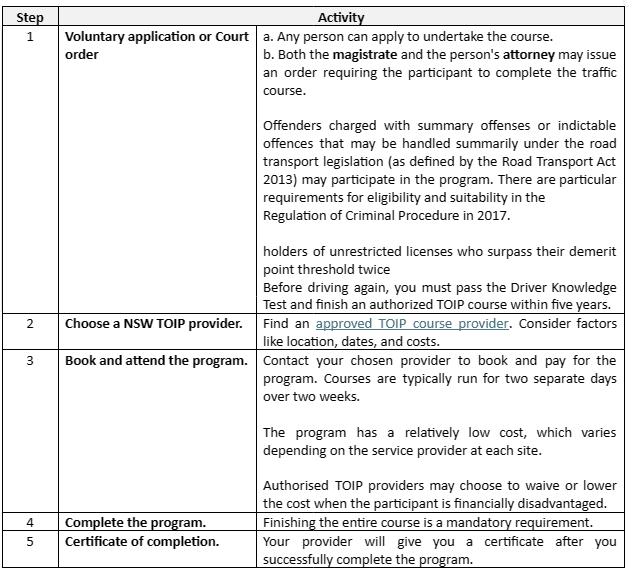The New South Wales government’s Traffic Offender Program is a proactive approach to the widespread traffic violations in the state. The programme’s objective is to provide offenders the knowledge and abilities they need to adopt safer driving behaviours and develop positive attitudes regarding driving.
The Traffic Offender Program (the proper term is “Traffic Offender Intervention Program or TOIP”) will educate drivers and other road users to be more responsible when driving. In this article, you will learn about:
- what happens during the programme or driver education course or driver education programmes
- the step-by-step process
- common traffic offences in NSW.
What Happens During the Traffic Offender Program?
The programme emphasises the real-world impact of dangerous driving. During the programme, facilitators will provide graphic presentations and testimonials from people who have been involved in or injured by serious traffic accidents. The presentation also includes discussions about:
- key facts and statistics,
- current road safety campaigns,
- behavioural strategies, and
- key messages.
Moreover, participants will delve into their driving history, the reasons behind their offences, and take responsibility for their actions. In this aspect, the programme will allow participants to identify the underlying reasons behind their traffic offences. Factors can include the following:
- Impulsivity
- Stress or anger.
- Substance use
- Peer pressure
- Disregard for the rules of the road.
Typically, TOIP courses run for two separate days over two weeks and the participant must finish the entire programme. They can be held in-person, virtually, or online depending on the provider. Individuals may be mandated to attend TOIP:
- after committing certain traffic offences or
- exceeding their demerit points within a specified period in NSW.
In order to break up sessions, providers should ask participants to participate in self-reflection exercises and group discussions and activities. Every module offers ideas for discussion topics and/or exercises that could encourage students to interact more with the course material.
To complete this course, the participant must:
- Complete the attendance.
- Participate actively during the discussions.
- Finish the course material.

Traffic Offender Program Step-by-step Process
To provide an overview of what you should do to participate in the traffic offender program, here’s a step-by-step process for easy reference:

Note: Apart from these requirements, training providers in the traffic offender program may impose additional requirements on participants in order to ensure a satisfactory completion of the course. Moreover, participants should be informed about the attendance and evaluation requirements prior to the start of the course in order for them to pass.
What You’ll Learn in the Completed TOIP Program
During the traffic offender program, you will learn about the following topics:
- Module 1: Impact of traffic offences/crashes (legal, cost to society)
- Module 2: Behavioural factors – Speeding
- Module 3: Behavioural factors – Drink driving
- Module 4: Behavioural factors – Drug driving
- Module 5: Behavioural factors – Fatigue
- Module 6: Behavioural factors – Mobile phone use and distraction
- Module 7: Vulnerable Road Users – Pedestrian, cyclists and motorcyclist
- Module 8: Vehicle safety, vehicle maintenance, restricted vehicles for provisional licence holders
TOIP Provider Report
According to the operating guidelines of the Traffic Offender Intervention Program, the providers must submit a Report to the Court regarding the participant’s attendance. The template of the required Report can be found in the TOIP Operating Guidelines (Appendix A).
For those who attended the traffic offender program because of a court order, the Criminal Procedure Regulation 2017 requires that the TOIP providers report back to the court on the offender’s attendance at the course. Before the offender’s subsequent court appearance, the report needs to be received by the court.
Here are the rules for the submission of the report:
- Satisfactory Attendance. The report must reach the court before the offender’s scheduled reappearance date if the participant attends satisfactorily. The TOIP provider must communicate with the appropriate court if required.
- Partial Attendance. When there is not enough time left in the course for the participant to reach a satisfactory attendance level, approved TOIP providers are must finish and submit the report back to the court on behalf of the participant who withdraws after completing part of it.
- Expelled Participant. Approved TOIP providers must finish and submit the report to the court as soon as the participant is expelled from the course.
- Voluntary Withdrawal. If the participant chooses to withdraw from the course, TOIP providers must complete and return the report to court as soon as possible after receiving a notice of withdrawal from the participant.

Consult a Traffic Offence Lawyer in NSW
Charged with a traffic offence in NSW and don’t know what to do? Seek legal advice from an experienced traffic offence lawyer first. Our lawyers at JB Solicitors can give you legal advice, provide representation during court hearings, and facilitate negotiations between parties. We can guide you throughout the entire process and provide legal support.
Schedule a consultation today through this link.
